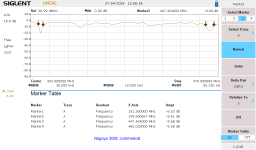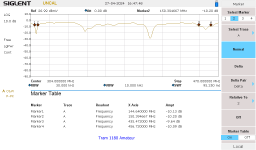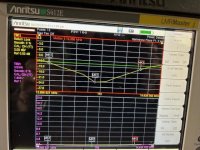I have a Spectrum Analyzer with a Tracking generator along with a RLB (Return Loss bridge).
I've been running scans on a number of Dual Band VHF/UHF (including 2 meter/440) mobile antennas mounted on a NMO counterpoise for evaluation and possible fine tuning that most seem to need. These tests were done in a FULL sized attic, NOT just a crawl space, that I confirmed did little to affect the scan compared to mounting it outside the roof thru a 'roof hatch' door. (no, I'm not kidding)
Can those scans be interpreted into a more meaningful VSWR number?
What I been doing is using a -10db figure to mark the bandwidth of the 'dips' for each band (see attachments). I choose that since anything less is really meaningless and any greater most of these would fail. Reading up on SA use and antennas, I'm under the impression that a 20db drop is a good figure with a -30 being optimum. Feel free to correct that and add any other input.
These models I choose, except for the Comet (which was the most expensive and the worst performer based on the UHF 'notch' drop), the others being Browning/Tram and Nagoya.
I hope all of that makes sense.
 (ignore the 'uncal', it's not relevant here)
(ignore the 'uncal', it's not relevant here)


I've been running scans on a number of Dual Band VHF/UHF (including 2 meter/440) mobile antennas mounted on a NMO counterpoise for evaluation and possible fine tuning that most seem to need. These tests were done in a FULL sized attic, NOT just a crawl space, that I confirmed did little to affect the scan compared to mounting it outside the roof thru a 'roof hatch' door. (no, I'm not kidding)
Can those scans be interpreted into a more meaningful VSWR number?
What I been doing is using a -10db figure to mark the bandwidth of the 'dips' for each band (see attachments). I choose that since anything less is really meaningless and any greater most of these would fail. Reading up on SA use and antennas, I'm under the impression that a 20db drop is a good figure with a -30 being optimum. Feel free to correct that and add any other input.
These models I choose, except for the Comet (which was the most expensive and the worst performer based on the UHF 'notch' drop), the others being Browning/Tram and Nagoya.
I hope all of that makes sense.





